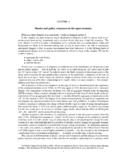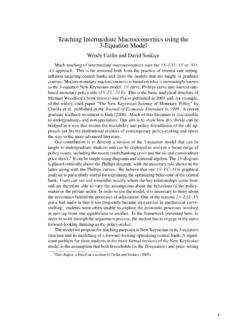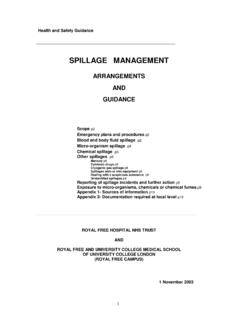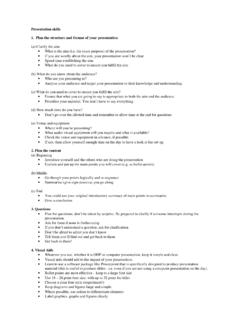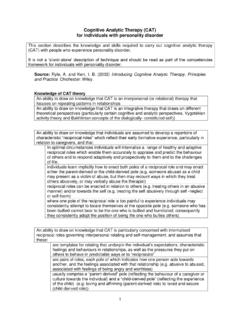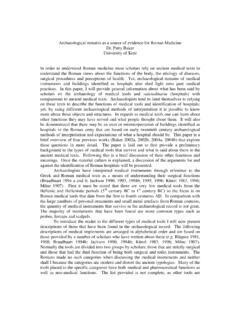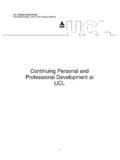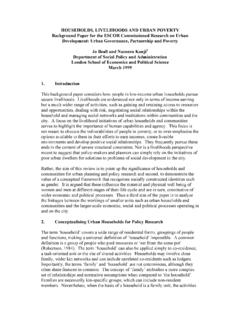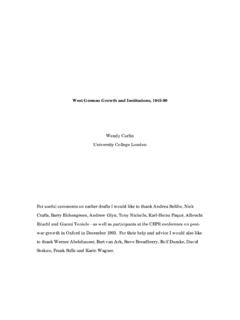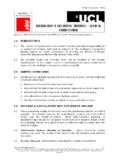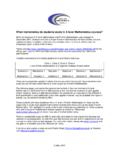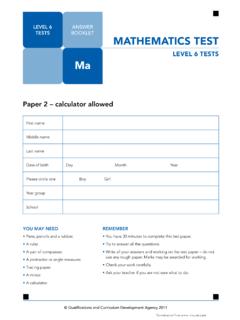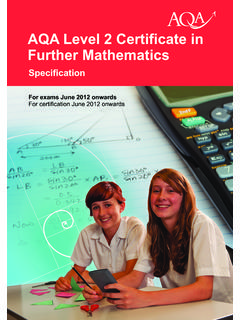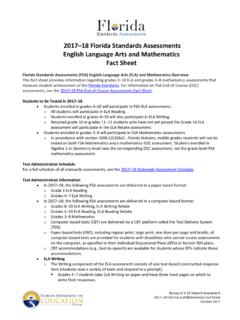Transcription of Notes and questions to aid A-level Mathematics revision
1 Notes and questions to aidA-level Mathematics revisionRobert BowlesUniversity College LondonOctober 24, 20051 Introduction21 IntroductionThere are some students who find the first year s study at UCL and many other universitiesdifficult. Of course there can be many reasons for this but these Notes aim to help overcomeproblems that may arise from:1. Difficulties students have carrying out algebraic manipulation accurately and best remedy for this is practice and more Difficulties which arise from a lack of knowledge, or more likely application of thestudents knowledge in new you work through this document and do the questions you will hopefully find yourselfbetter prepared for starting your course at UCL.
2 You are likely to find that the pace of auniversity Mathematics course is greater that is the case atschool. New ideas and resultswill be introduced and used in rapid sucession. You will be better able to cope with thedifficulties this can lead to if you are totally familiar with the material you have covered atschool. It is also worth starting to prepare now for the fact that in the Mathematics examsat UCL you are not allowed the use of a calculator, a book of tables or a formula sheet!The material here concentrates on some of the knowledge and techniques required forthe first term M14A methods course although you will also find it helpful for the appliedmathematics course M13A.
3 It does not cover everything you will need to note carefully:1. There is a core A-level syllabus whichallstudents completing a single maths A-levelmay be expected to know. Much of the material below is in the core A-level syllabusbut some is on the edges of the core and you may not be familiar with it especiallythose of you with a single Mathematics A-level . A little material is definitely notin the core but is presented here anyway because it follows naturally from The entrance requirements at UCL do not require two A- levels in Mathematics . In-deed to insist on such qualifications could well prevent manystudents from studyingmaths at university.
4 At UCL a great deal of effort is expended by the lecturers inthe first year to make the course accessible to those with a single maths A-level . Theoff-core and further Mathematics material is covered. However it is often coveredbriefly and it is in your interest to spend some time familiarising yourself with itnow. These Notes will help you in that task also. Over 60% of our students do infact have Further Mathematics It is hoped, but not guaranteed, that there will be additional lectures covering someof the material in these Notes during the first few weeks of thecourse at UCL. So,should you find that these Notes do not help you prepare adequately, extra supportmay be available Introduction34.
5 Be prepared to have to use your current A-level Notes and texts to help answer someof the Few answers are given in these Notes . Remember to check an integration all you needto do is differentiate and its good practice too. To check a division, multiply out. Tocheck a partial fraction, put it together again any comments on the relevance and difficulty of these exercise and examples willbe gratefully received and will help enormously in improving this document for studentsin years to come. Look out for mistakes. I know there are a few in BowlesOctober 24, 20052 Algebraic Manipulation42 Algebraic Completing the squareYou should knowhow tocomplete the squareand be able to writeax2+bx+c=a(x+b/2a)2+c b2 the square fora)x2+ 2x+ 1,b) 3x2+ 4x 5 c) 2 3x x2,d)c+dx SurdsYou should knowhow to manipulatesurdsExample 2 + 1 2 1=( 2 + 1 2 1)( 2 + 1 2 + 1)=( 2 + 1)22 1,as (u+ 1)(u 1) =u2 1, withu= 2, so 2 + 1 2 1=2 + 2 2 + 11= (3 + 2 2)Qu.
6 1(1 2)2 1(1 + 2)2= 4 2,b)3 2 + 2 33 2 2 3= 5 + 2 6,c) ln( 2 1) = ln( 2 + 1),d)x y+ x+x y x=2x yy lnxis the natural logarithm, or logarithm to baseeofx. In addition we may writeexor exp(x) to meaneraised to the powerx3 Trigonometrical Formulae53 Trigonometrical Elementary FormulaeYou should know1. The definitionscosec = 1/sin sec = 1/cos cot = 1/tan 2. Pythagoras theoremsin2 + cos2 = 1(H)sec2 = tan2 + 1cosec2 = cot2 + 1.(How do we get these last two from the firstH?)3. Thecompound angle formulaesin(a+b) = sinacosb+ cosasinb,(N)sin(a b) = sinacosb cosasinb,cos(a+b) = cosacosb sinasinb,cos(a b) = cosacosb+ sinasinb,tan(a+b) =tana+ tanb1 tanatanb,tan(a b) =tana tanb1 + tanatanb,(Can you figure out how to derive these starting from just the first oneN?
7 Can you proveN?. What assumptions do you start from?)4. Thedouble angle formulaesin 2a= 2 sinacosa,cos 2a= cos2a sin2a= 1 2 sin2a= 2 cos2a 1,tan 2a=2 tana1 tan2a.(Can you derive these from the compound angle formulae?) Elementary Formulae6In addition you should knowthe sine, cosine and tangent of the angles 0, /6, /4, /3, /2, 2 /3, 3 /4, etc and from them be able to evaluate the cosecant, secantand cotangent. Also you should be able to use the symmetries in the graphs of thetrigonometric functions to find values for arguments outside the range 0 to /2, includingnegative values of the argument. Notice radians are now the preferred measure of +cota= sinacosa=sin + cota=1sinacosa+cosasina=sinacosasin2a+ cos2a= sinacosaand12sin 2a=122 sinacosa= ) If sin = 1/4, what is sin( ), sin( + ) and sin(2 ).
8 2) If tan = , write down cot( ), cot(3 ) and cot( ).3) Write in surd form sin , cos , tan , sec and cot when = 5 /6, = 2 /3 and = 7 ) Find in the range 0 to 2 if sin = 1/2 and tan = 1/ ) Showa) cot tan = 2 cot 2 ,b) cosec 2 cot 2 = cot ,c)sin 1 + cos = tan( /2),d)sin 2 + cos 2 + 1sin 2 cos 2 + 1= cot .6) If sina= 1/ 10 and sinb= 1/ 5 show sin(a+b) = 1/ ) Showsec + cosec tan + cot =tan cot sec cosec .8) Showa) sec2 + cosec2 = 4 cosec22 ,b) tan + cot =2sin 2 ,c) sin(a+b) sin(a b) = sin2a Using these Using these resultsYou should knowthat the expressionacos +bsin may be written in the formRcos( ) orRsin( ) for positiveR, although and may be of either sign.
9 IfRcos( ) =Rcos cos +Rsin sin =acos +bsin ,thenRcos =a,Rsin =b,so that squaringR2=a2+b2,cos =a a2+b2,sin =b a2+b2,tan =baExampleFind the maximum and minimum value of 2 cos + 3 sin 2 cos + 3 sin =Rcos( )whereR2= 22+ 32= 13,tan = 3/2 The maximum value occurs where ( ) = 0 so for = arctan(3/2). The maximumisR= 13. Note I am happy to leave the answer in this form and not obtain anapproximate value of orRby using a calculator. You will not be allowed to usecalculators in nearly all your exams at ) Show cos + sin = 2 cos( /4) and find the solutions in the range to tothe equation cos + sin = 1 together with the maximum and minimum values ofthe ) Find the range of values in 0 to 2 for which a) 2 sin + cos is positive andb) 4 cos 3 sin is More More formulaeYou should knowthe formulaesin + sin = 2 sin( + 2)cos( 2),sin sin = 2 cos( + 2)sin( 2),cos + cos = 2 cos( + 2)cos( 2),cos cos = 2 sin( + 2)sin( 2),(How do you derive these from the compound angle formulae?
10 4 Geometric SeriesYou should knowThe formula for the sum tonterms of the geometric seriesa+ar+ar2+ar3+ +arn 1=a1 rn1 r,and that if|r|<1, the sum to infinity isa/(1 r)Example1. The series 2, 2/3, 2/9, 2/27, etc has first terma= 2 and common ratior= 1/3which has|r|<1 and the series has a sum equal to 2/(1 1/3) = 6/(3 1) = The seriessin 2 sin 2 cos 2 + sin 2 cos22 + ,has a first terma= sin 2 and a common ratio ( cos 2 ) and so a sum toinfinity of sin 2 /(1 + cos 2 ) = 2 sin cos /2 cos2 = tan if|cos |< The Binomial Expansion9Qu. ) Find the sum to infinity, when it exists, ofa) 5,10,20,40, .. ,b) 1/2,1/4,1/8,1/16.
